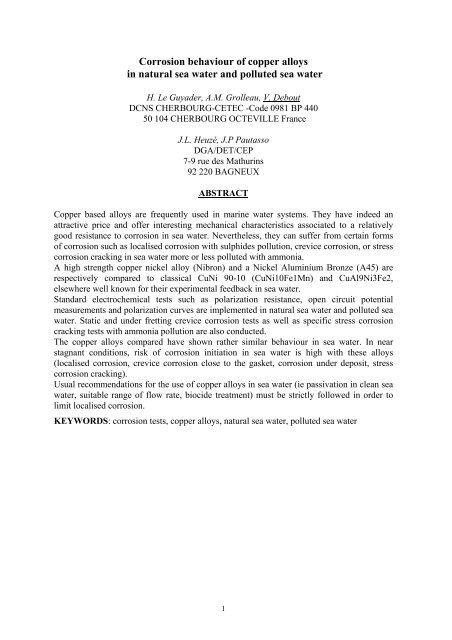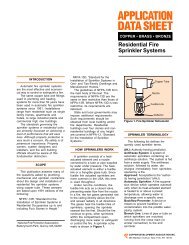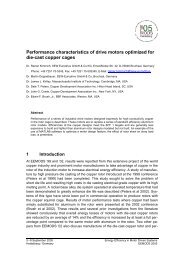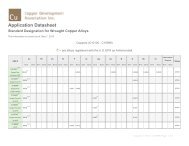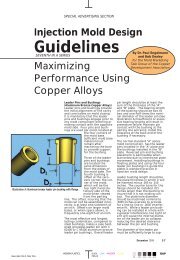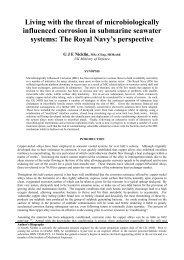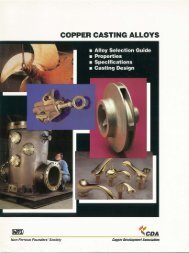Corrosion behaviour of copper alloys in natural sea water and ...
Corrosion behaviour of copper alloys in natural sea water and ...
Corrosion behaviour of copper alloys in natural sea water and ...
- No tags were found...
You also want an ePaper? Increase the reach of your titles
YUMPU automatically turns print PDFs into web optimized ePapers that Google loves.
<strong>Corrosion</strong> <strong>behaviour</strong> <strong>of</strong> <strong>copper</strong> <strong>alloys</strong><strong>in</strong> <strong>natural</strong> <strong>sea</strong> <strong>water</strong> <strong>and</strong> polluted <strong>sea</strong> <strong>water</strong>H. Le Guyader, A.M. Grolleau, V. DeboutDCNS CHERBOURG-CETEC -Code 0981 BP 44050 104 CHERBOURG OCTEVILLE FranceJ.L. Heuzé, J.P PautassoDGA/DET/CEP7-9 rue des Mathur<strong>in</strong>s92 220 BAGNEUXABSTRACTCopper based <strong>alloys</strong> are frequently used <strong>in</strong> mar<strong>in</strong>e <strong>water</strong> systems. They have <strong>in</strong>deed anattractive price <strong>and</strong> <strong>of</strong>fer <strong>in</strong>terest<strong>in</strong>g mechanical characteristics associated to a relativelygood resistance to corrosion <strong>in</strong> <strong>sea</strong> <strong>water</strong>. Nevertheless, they can suffer from certa<strong>in</strong> forms<strong>of</strong> corrosion such as localised corrosion with sulphides pollution, crevice corrosion, or stresscorrosion crack<strong>in</strong>g <strong>in</strong> <strong>sea</strong> <strong>water</strong> more or less polluted with ammonia.A high strength <strong>copper</strong> nickel alloy (Nibron) <strong>and</strong> a Nickel Alum<strong>in</strong>ium Bronze (A45) arerespectively compared to classical CuNi 90-10 (CuNi10Fe1Mn) <strong>and</strong> CuAl9Ni3Fe2,elsewhere well known for their experimental feedback <strong>in</strong> <strong>sea</strong> <strong>water</strong>.St<strong>and</strong>ard electrochemical tests such as polarization resistance, open circuit potentialmeasurements <strong>and</strong> polarization curves are implemented <strong>in</strong> <strong>natural</strong> <strong>sea</strong> <strong>water</strong> <strong>and</strong> polluted <strong>sea</strong><strong>water</strong>. Static <strong>and</strong> under frett<strong>in</strong>g crevice corrosion tests as well as specific stress corrosioncrack<strong>in</strong>g tests with ammonia pollution are also conducted.The <strong>copper</strong> <strong>alloys</strong> compared have shown rather similar <strong>behaviour</strong> <strong>in</strong> <strong>sea</strong> <strong>water</strong>. In nearstagnant conditions, risk <strong>of</strong> corrosion <strong>in</strong>itiation <strong>in</strong> <strong>sea</strong> <strong>water</strong> is high with these <strong>alloys</strong>(localised corrosion, crevice corrosion close to the gasket, corrosion under deposit, stresscorrosion crack<strong>in</strong>g).Usual recommendations for the use <strong>of</strong> <strong>copper</strong> <strong>alloys</strong> <strong>in</strong> <strong>sea</strong> <strong>water</strong> (ie passivation <strong>in</strong> clean <strong>sea</strong><strong>water</strong>, suitable range <strong>of</strong> flow rate, biocide treatment) must be strictly followed <strong>in</strong> order tolimit localised corrosion.KEYWORDS: corrosion tests, <strong>copper</strong> <strong>alloys</strong>, <strong>natural</strong> <strong>sea</strong> <strong>water</strong>, polluted <strong>sea</strong> <strong>water</strong>1
INTRODUCTIONCopper based <strong>alloys</strong> are frequently used <strong>in</strong> <strong>sea</strong> <strong>water</strong> system for applications such as heatexchangers, pumps, valves, pipes, fasteners. Depend<strong>in</strong>g on the applications <strong>and</strong> the need formechanical characteristics, CuNi <strong>alloys</strong> (ie CuNi10Fe1Mn) or Nickel Alum<strong>in</strong>ium Bronzescan be used. Despite the emergence <strong>in</strong> recent years <strong>of</strong> other materials that <strong>of</strong>fer improvedproperties such as sta<strong>in</strong>less steels, based nickel <strong>alloys</strong> or titanium, <strong>copper</strong> <strong>alloys</strong> cont<strong>in</strong>ue tobe widely used. They have <strong>in</strong>deed an attractive price <strong>and</strong> <strong>of</strong>fer <strong>in</strong>terest<strong>in</strong>g mechanicalcharacteristics associated to a relatively good resistance to corrosion <strong>in</strong> <strong>sea</strong> <strong>water</strong>.Nevertheless, they can suffer from certa<strong>in</strong> forms <strong>of</strong> corrosion such as localised corrosionwith sulphides pollution [1-6], crevice corrosion <strong>in</strong> valves or flanges assemblies [7-9]. Somecases <strong>of</strong> stress corrosion crack<strong>in</strong>g <strong>in</strong> <strong>sea</strong> <strong>water</strong> more or less polluted with ammonia were alsoreported [10-12].This paper summarises the results <strong>of</strong> a comparative test campaign conducted <strong>in</strong> <strong>natural</strong> <strong>sea</strong><strong>water</strong> <strong>and</strong> polluted <strong>sea</strong> <strong>water</strong> on a high strength <strong>copper</strong> nickel alloy (Nibron compared to theclassical CuNi10Fe1Mn) <strong>and</strong> a Nickel Alum<strong>in</strong>ium Bronzes (A45 compared toCuAl9Ni3Fe2). Nibron <strong>and</strong> A45 be<strong>in</strong>g dedicated for fastener applications.The follow<strong>in</strong>g classical electrochemical tests were first conducted <strong>in</strong> <strong>natural</strong> <strong>sea</strong> <strong>water</strong> toassess corrosion parameters <strong>in</strong> the absence <strong>of</strong> critical <strong>in</strong>terface:-Open circuit potential (Eoc) <strong>and</strong> polarization resistance (Rp)-Anodic polarization curves-Weight loss measurements <strong>and</strong> corrosion rates estimation.Secondly, the <strong>in</strong>fluence <strong>of</strong> sulphide or ammonia pollutions was <strong>in</strong>vestigated through thesame approach.Thirdly, critical <strong>in</strong>terface that simulated flanges assemblies were considered <strong>and</strong> testedthrough crevice corrosion potentiostatic tests with a potential imposed close to Eoc.Then, as relative micro displacements could be generated <strong>in</strong> certa<strong>in</strong> assemblies, comparativetests regard<strong>in</strong>g crevice corrosion <strong>in</strong>itiation under frett<strong>in</strong>g were also carried out.F<strong>in</strong>ally, as NAB could be susceptible to Stress <strong>Corrosion</strong> Crack<strong>in</strong>g (SCC) <strong>in</strong> <strong>natural</strong> <strong>sea</strong><strong>water</strong> or polluted <strong>sea</strong> <strong>water</strong> with ammonia, SCC U-bend tests were conducted.MaterialsEXPERIMENTAL PROCEDURENom<strong>in</strong>al compositions <strong>and</strong> mechanical properties <strong>of</strong> the base materials used are found <strong>in</strong>tables 1 <strong>and</strong> 2 with reference to certificate data, but also to analysis <strong>and</strong> mechanical testsconducted by the CESMAN 1 depend<strong>in</strong>g on the material considered.Specimens condition<strong>in</strong>gAll specimens used were wet polished to a f<strong>in</strong>al f<strong>in</strong>ish with 600-grade SiC paper exceptSCC specimens that were polished to a 240-grit f<strong>in</strong>ish, degreased <strong>in</strong> methanol, r<strong>in</strong>sed <strong>in</strong>deionised <strong>water</strong> <strong>and</strong> then air dried. Prior to test<strong>in</strong>g, all specimens were immersed <strong>in</strong>circulat<strong>in</strong>g <strong>natural</strong> <strong>sea</strong> <strong>water</strong> (2l/m<strong>in</strong>) dur<strong>in</strong>g about one month. Sea <strong>water</strong> is pumped fromCherbourg harbour with the temperature vary<strong>in</strong>g from 17°C to 20°C dur<strong>in</strong>g the period <strong>of</strong>tests.1 CESMAN Centre d’Expertises des Structures et MAtériaux Navals (de DCNS)2
<strong>Corrosion</strong> test<strong>in</strong>gEoc <strong>and</strong> Rp measurementsEoc <strong>and</strong> Rp measurements were conducted on specimens mach<strong>in</strong>ed from bars with a flagshape to enable electric connection out <strong>of</strong> them <strong>sea</strong> <strong>water</strong>, the dimensions be<strong>in</strong>g <strong>of</strong> 25 mm <strong>in</strong>length <strong>and</strong> 25 mm <strong>in</strong> width. Eoc was measured with respect to Saturated Calomel referenceElectrode (SCE). Rp measurements were obta<strong>in</strong>ed with l<strong>in</strong>ear polarization data acquiredus<strong>in</strong>g a potentiostat by impos<strong>in</strong>g a small amplitude potential <strong>of</strong> 15 mV around Eoc. Thesweep rate was 0.05 mV/s. Rp was taken as the slope <strong>of</strong> the I= f(E) curve near Eoc.Triplicate specimens were weighted before immersion <strong>and</strong> after clean<strong>in</strong>g with descal<strong>in</strong>gsolvents. Comparisons were made <strong>in</strong> each case with control specimens. Weight lossmeasurements were used to estimate the corrosion rates <strong>in</strong> µm/year. Specimen exam<strong>in</strong>ationwas conducted before <strong>and</strong> after clean<strong>in</strong>g. Tests were conducted <strong>in</strong> <strong>natural</strong> <strong>sea</strong> <strong>water</strong> dur<strong>in</strong>gabout 3 months but also <strong>in</strong> polluted <strong>sea</strong> <strong>water</strong> with sulphides or ammonia. Sea <strong>water</strong>pollution was simulated through Na 2 S addition <strong>of</strong> 10 ppm S 2- , <strong>in</strong> quiescent <strong>sea</strong> <strong>water</strong>(Contact time 30 m<strong>in</strong> before recirculation) every day dur<strong>in</strong>g 5 days. The results obta<strong>in</strong>ed <strong>in</strong>non polluted circulat<strong>in</strong>g <strong>sea</strong> <strong>water</strong> were compared to those <strong>in</strong> polluted <strong>sea</strong> <strong>water</strong> after about3 months <strong>of</strong> test. Ammonia additions were considered as another possible pollution that canbe encountered <strong>in</strong> stagnant conditions due to organic matter degradation. NH 4 OH was thenadded to stagnant <strong>sea</strong> <strong>water</strong> up to 1700 ppm <strong>of</strong> NH 3 , renewed every 2 weeks dur<strong>in</strong>g morethan one month. The results obta<strong>in</strong>ed <strong>in</strong> stagnant <strong>sea</strong> <strong>water</strong> renewed every 2 weeks werecompared to those <strong>in</strong> stagnant <strong>sea</strong> <strong>water</strong> polluted with ammonia.Polarization curvesThe anodic polarization curves were generated us<strong>in</strong>g a potentiostat, at a scan rate <strong>of</strong> 0.05mV/s, from Eoc to 0.3 V vs. SCE. The tests were conducted on “flag specimen” <strong>of</strong> 25 mm<strong>in</strong> length <strong>and</strong> 25 mm <strong>in</strong> width. Conditions <strong>of</strong> tests were the same as those selected for Eocmeasurements.Static crevice corrosion testsThe crevice device, shown <strong>in</strong> fig 1, was used <strong>in</strong> order to simulate metal /gasket <strong>in</strong>terfacessuch as flanges assembly under static conditions. The gaskets were aramid fiber gaskets <strong>and</strong>the assemblies were tightened to a controlled torque <strong>of</strong> 25 N.m lead<strong>in</strong>g to a pressure about20 N/mm 2 . It was lower than <strong>in</strong> service pressure but considered as a significant condition.One <strong>of</strong> the metallic surface was enlarged to enable crevice <strong>in</strong>itiation out <strong>of</strong> the <strong>in</strong>terface as itwas generally observed <strong>in</strong> service. Potentiostatic tests, at ambient temperature, wereconducted dur<strong>in</strong>g 73 days <strong>in</strong> circulat<strong>in</strong>g <strong>natural</strong> <strong>sea</strong> <strong>water</strong> under an imposed potential chosenclose to the Eoc measured.Crevice corrosion tests under frett<strong>in</strong>gAssemblies used for crevice corrosion test<strong>in</strong>g assisted by frett<strong>in</strong>g consisted <strong>of</strong> threespecimens with cyl<strong>in</strong>drical bosses fastened through their central hole with a controlledpressure <strong>of</strong> 2 N/mm 2 as shown <strong>in</strong> figure 2. The tests were performed <strong>in</strong> <strong>natural</strong> <strong>sea</strong> <strong>water</strong> at acontrolled temperature <strong>of</strong> 25°C. Micro–displacements <strong>of</strong> 10 microns were generated at afrequency <strong>of</strong> 10 Hz for 2 or 3 hours. Potentiostatic tests were conducted <strong>in</strong>creas<strong>in</strong>g thepotential step by step. The first phase consist <strong>of</strong> wait<strong>in</strong>g for steady current close to Eocpotential, then implement<strong>in</strong>g a frett<strong>in</strong>g sequence <strong>and</strong> record<strong>in</strong>g the correspond<strong>in</strong>g current.Then, potential was <strong>in</strong>creased <strong>and</strong> the frett<strong>in</strong>g sequence implemented. This step wasrepeated until the current reached 10 -4 to 10 -3 Amps.3
Stress corrosion crack<strong>in</strong>g testsU-Bend tests were conducted accord<strong>in</strong>g to ISO 7539-3 st<strong>and</strong>ard (ref 13).Tests parameterswere selected with regard to those def<strong>in</strong>ed previously to estimate CuAl9Ni3Fe2 SCCsusceptibility <strong>in</strong> <strong>natural</strong> <strong>sea</strong> <strong>water</strong> <strong>and</strong> polluted stagnant <strong>sea</strong> <strong>water</strong> with aqueous ammonia[14]. Specimens were bent to a bend<strong>in</strong>g radius <strong>of</strong> 14 mm. Test environments chosen were<strong>natural</strong> <strong>sea</strong> <strong>water</strong> <strong>and</strong> stagnant <strong>sea</strong> <strong>water</strong> added with two concentrations <strong>of</strong> aqueousammonia: 170 ppm (0.01 mol/l) <strong>and</strong> 1700 ppm(0.1 mol/l). Cracks were <strong>in</strong>deed observed onCuAl9Ni3Fe2 <strong>in</strong> these conditions after respectively 1000 h <strong>and</strong> 120 h <strong>of</strong> test duration(ref14). Each specimen was duplicated <strong>and</strong> two test durations were selected, 1000 hours <strong>and</strong>5000 hours (four specimens tested <strong>in</strong> each condition).RESULTS AND DISCUSSION<strong>Corrosion</strong> parameters <strong>in</strong> <strong>natural</strong> <strong>sea</strong> <strong>water</strong> (absence <strong>of</strong> critical <strong>in</strong>terface)Eoc measurements <strong>of</strong> Nibron compared to CuNi10Fe1Mn are given <strong>in</strong> Figure 3. In <strong>natural</strong><strong>sea</strong> <strong>water</strong>, Nibron Eoc is ma<strong>in</strong>ta<strong>in</strong>ed around -250 mV vs. SCE over a period <strong>of</strong> time <strong>of</strong> aboutone month. Then, Eoc <strong>in</strong>creases to -70 mV vs. SCE after 2 months <strong>of</strong> test. The triplicatespecimens <strong>in</strong> test give the same results.Rp measurements <strong>of</strong> Nibron , shown <strong>in</strong> Figure 4, confirms this tendency to corrosion<strong>in</strong>itiation with an <strong>in</strong>itial value <strong>of</strong> 5000 to 10 000 Ohm decreas<strong>in</strong>g to between 10 <strong>and</strong> 300Ohm after 2 months <strong>of</strong> exposure to <strong>sea</strong> <strong>water</strong>. Nibron specimens exam<strong>in</strong>ations, presented <strong>in</strong>Figure 5, shows green oxidation products significant <strong>of</strong> corrosion <strong>in</strong>itiation. The meancorrosion rate is nevertheless low around 18 µm/year. Pitt<strong>in</strong>g corrosion is observed but thepit depths are too low to be estimated. After one month <strong>of</strong> exposure to <strong>natural</strong> <strong>sea</strong> <strong>water</strong>,anodic polarization curves, <strong>in</strong> Figure 6, exhibit no actual passivation threshold, the currentdensity <strong>in</strong>creases from 10 -7 A/cm 2 to about 10 -5 A/cm 2 up to a potential <strong>of</strong> -50 mV vs. SCE.Over this potential, anodic current sharply <strong>in</strong>creases to 10 -3 A/cm 2 . If Nibron is compared tothe classical CuNi10Fe1Mn, mean corrosion rate could be considered similar respectively18 µm/year <strong>and</strong> 15 µm/year but Nibron could have a higher tendency to pitt<strong>in</strong>g <strong>in</strong> <strong>natural</strong><strong>sea</strong> <strong>water</strong>. Eoc <strong>and</strong> Rp measurements confirm this different <strong>behaviour</strong>. CuNi10Fe1Mnpresents <strong>in</strong>deed a steady potential <strong>and</strong> Rp with time, respectively -200 mV vs. SCE <strong>and</strong>2000 Ohm as Nibron shows an <strong>in</strong>crease <strong>in</strong> potential over -100 mV vs. SCE <strong>and</strong> a decrease <strong>in</strong>Rp under 100 Ohm after 2 months <strong>of</strong> exposure to <strong>sea</strong> <strong>water</strong>.In conclusion, Nibron could be considered a bit more susceptible to corrosion <strong>and</strong> especiallylocalised corrosion than CuNi10Fe1Mn <strong>in</strong> <strong>natural</strong> <strong>sea</strong> <strong>water</strong>.Eoc measurements <strong>of</strong> A45 compared to the NAB CuAl9Ni3Fe2 are given <strong>in</strong> Figure 7.Similar phenomenon is observed on both <strong>alloys</strong>, that is an <strong>in</strong>crease <strong>in</strong> potential from -250mV vs. SCE to -90 mV vs. SCE after 2 months <strong>of</strong> exposure to <strong>sea</strong> <strong>water</strong>. At the same time,Rp shown <strong>in</strong> Figure 8, presents similar evolution with a decrease from a steady value <strong>of</strong>3000 Ohm to 100 Ohm after 2 months <strong>of</strong> test. Specimen exam<strong>in</strong>ations reveal a meancorrosion rate <strong>of</strong> 37 µm/year with a localised corrosion observed near the coated electricconnection evaluated at 1.3 mm/year, the max. depth be<strong>in</strong>g <strong>of</strong> about 150 to 300 µm. Similarobservations are made on CuAl9Ni3Fe2. Anodic polarization curves performed on A45 <strong>and</strong>CuAl9Ni3Fe2 , <strong>in</strong> Figures 9 <strong>and</strong> 10, are very similar. No actual passivation thresholds areobserved <strong>in</strong> both cases. For A45, current densities <strong>in</strong>crease slowly from 10 -6 A/cm 2 to 10 -54
A/cm 2 between -220 mV vs. SCE <strong>and</strong> -100 mV vs. SCE. Then, over – 100 mV vs. SCE ,current densities sharply <strong>in</strong>crease to 10 -3 A/cm 2 .In conclusion, electrochemical <strong>behaviour</strong> <strong>of</strong> A45 <strong>and</strong> CuAl9Ni3Fe2 are very similar with ahigher tendency to localised corrosion <strong>of</strong> these both <strong>alloys</strong> compared to Nibron orCuNi10Fe1Mn.Influence <strong>of</strong> sulphides pollution on corrosion parametersWith suphides pollution, Eoc measured on Nibron shown <strong>in</strong> Figure 3 <strong>in</strong>creases from - 250mV vs. SCE to -70 mV vs SCE after 2 months <strong>of</strong> test, as it was observed <strong>in</strong> <strong>natural</strong> <strong>sea</strong><strong>water</strong>. At the same time Rp , <strong>in</strong> Figure 4, decreases to 100 Ohm. Specimen exam<strong>in</strong>ationafter the test, reveals an important green oxides deposit as shown <strong>in</strong> Figure 5 with a meancorrosion rate estimated about 49 µm/year. Nibron anodic polarization curve with sulphidespollution is very similar to those <strong>of</strong> CuNi10Fe1Mn. Anodic current, <strong>in</strong> Figure 6, sharply<strong>in</strong>creases to 10 -4 A/cm 2 for a potential between -100 mV vs. SCE <strong>and</strong> -30 mVvs.SCE.In conclusion, with sulphides pollution, Nibron presents a comparative <strong>behaviour</strong> toCuNi10Fe1Mn. Compared to results <strong>in</strong> <strong>natural</strong> <strong>sea</strong> <strong>water</strong>, mean corrosion rates are <strong>in</strong>creased<strong>and</strong> affected areas are spread all over the exposed surface <strong>in</strong> both cases.Influence <strong>of</strong> ammonia pollution on corrosion parametersWith ammonia pollution, A45 Eoc, shown <strong>in</strong> Figure 11, decreases from – 250 mV vs ECS to-350 mV vs. ECS. This decrease <strong>in</strong> potential was checked on Pt Electrode. The samephenomenon is also observed on CuAl9Ni3Fe2 (see Figure 12). Specimen exam<strong>in</strong>ationsafter the tests reveal a superficial corrosion with no significant pitt<strong>in</strong>g. The mean corrosionrates for A45 <strong>and</strong> CuAl9Ni3Fe2 are respectively 13 µm/year <strong>and</strong> 16 mm/year. Anodicpolarization curves performed on A45 <strong>and</strong> CuAl9Ni3Fe2, <strong>in</strong> Figure 9 <strong>and</strong> 10 reveal asignificant <strong>in</strong>crease <strong>in</strong> current between -150 mV vs. SCE <strong>and</strong> – 250 mV vs. SCE <strong>in</strong> <strong>sea</strong> <strong>water</strong>with ammonia pollution. The current densities reach 7.10 -5 A/cm 2 .In conclusion, these tests reveal the potential risk <strong>of</strong> galvanic coupl<strong>in</strong>g between a surfacepolluted with ammonia <strong>and</strong> a large surface <strong>in</strong> unpolluted <strong>natural</strong> <strong>sea</strong> <strong>water</strong>.Parameters <strong>of</strong> crevice corrosion <strong>in</strong>itiation (Static tests) <strong>in</strong> <strong>natural</strong> <strong>sea</strong> <strong>water</strong>Tests conducted on Nibron, under – 70 mV vs ECS <strong>in</strong> Figure 13, lead to a high currentaround 10 -3 A/cm 2 after 100 hours <strong>of</strong> test. A uniform corrosion is observed, localised out <strong>of</strong>the crevice <strong>in</strong>terface. CuNi10Fe1Mn presents exactly the same phenomenon with lowercurrent about 5. 10 -5 A/cm 2 under a potential <strong>of</strong> -75 mV vs.ECS.On A45, the current measured under – 100 mV vs SCE is 10 -5 A/cm 2 after 100 hours <strong>of</strong> test.Then, it <strong>in</strong>creases gradually to 10 -4 A/cm 2 (see Figure 14). <strong>Corrosion</strong> is observed out <strong>of</strong> thecrevice <strong>in</strong>terface but localised at the edge <strong>of</strong> the gasket. A45 <strong>and</strong> CuAl9Ni3Fe2 show a verysimilar <strong>behaviour</strong>.In conclusion, the various materials tested show a certa<strong>in</strong> susceptibility to crevice corrosion.In each case, this corrosion is localised out <strong>of</strong> the crevice <strong>in</strong>terface <strong>and</strong> close to the gasketedge <strong>in</strong> the case <strong>of</strong> NAB.5
Parameters <strong>of</strong> crevice corrosion <strong>in</strong>itiation <strong>and</strong> propagation under frett<strong>in</strong>g <strong>in</strong> <strong>natural</strong> <strong>sea</strong> <strong>water</strong>On the Nibron crevice device, tests beg<strong>in</strong> under a potential <strong>of</strong> -150 mVvs.SCE. As shown <strong>in</strong>Figure 15, currents are ma<strong>in</strong>ta<strong>in</strong>ed low (10 -6 A) for a potential vary<strong>in</strong>g from – 150 mV vsSCE to -100 mV vs SCE. Above these potential, currents become significant from -70 mVvs SCE <strong>and</strong> reach 8. 10 -4 A. Frett<strong>in</strong>g <strong>in</strong>duces no significant <strong>in</strong>crease <strong>in</strong> current. For imposedpotentials from -60 mV vs. SCE to -50 mV vs. SCE, corrosion currents are very high(2.10 -3 A). After the tests, specimen exam<strong>in</strong>ation, presented <strong>in</strong> Figure 16, reveals superficialcorroded areas at the periphery <strong>and</strong> corrosion <strong>in</strong>itiates near the hole but this corrosion hasoccurred dur<strong>in</strong>g the <strong>in</strong>itial immersion phase but not dur<strong>in</strong>g the frett<strong>in</strong>g step.A comparative test conducted on CuNi10Fe1Mn with the results shown on Figure 17 <strong>and</strong>18 leads to the same conclusions with no significant effect <strong>of</strong> the frett<strong>in</strong>g observed. Initiationpotential is estimated around -70 mV vs. SCE under static conditions as under frett<strong>in</strong>g.<strong>Corrosion</strong> areas are also ma<strong>in</strong>ly located at the periphery <strong>of</strong> the specimen.On A45 (see Figure 19), corrosion <strong>in</strong>itiates <strong>natural</strong>ly under free potential ( -105 mV vs.SCE) at the beg<strong>in</strong>n<strong>in</strong>g <strong>of</strong> the test. Under – 100 mV vs. SCE, the current reaches 2. 10 -4 Awhich is higher than those observed on Nibron <strong>and</strong> CuNi10Fe1Mn <strong>in</strong> the same conditions.Under -80 mV vs. SCE, frett<strong>in</strong>g has got an effect on the current measured: after a frett<strong>in</strong>gstep <strong>of</strong> about one hour, corrosion current <strong>in</strong>creases from 4.410 -4 A to 6.2 10 -4 A. From – 70mVvs SCE, the current measured become very high (10 -3 A) but similar under staticconditions <strong>and</strong> under frett<strong>in</strong>g. Specimen exam<strong>in</strong>ation, shown on Figure 20, reveals after thefrett<strong>in</strong>g test a selective corrosion at the periphery <strong>of</strong> the specimen with dealum<strong>in</strong>isation, themaximum corrosion depth be<strong>in</strong>g <strong>of</strong> 0.1 mm.The comparative test conducted on CuAl9Ni3Fe2,<strong>in</strong> Figures 21 <strong>and</strong> 22, leads to similarobservations with lower currents measured. Under -100 mV vs. SCE, the current measuredis <strong>in</strong>deed 9 fold higher on A45. In both cases, A45 <strong>and</strong> CuAl9Ni3Fe2, frett<strong>in</strong>g beg<strong>in</strong>s to beeffective from -80 mV vs SCE with high steady currents that reached respectively 6.2 10 -4A <strong>and</strong> 2.8 10 -3 A. The crevice corrosion test under static conditions previously presented,seems to be less severe with corrosion current measured around 10 -4 A under a potential <strong>of</strong> –100 mV vs.SCE.In conclusion, <strong>in</strong>itiation potentials <strong>in</strong> static conditions <strong>and</strong> under frett<strong>in</strong>g are similar butfrett<strong>in</strong>g could have an effect on corrosion rates especially on A45 <strong>and</strong> CuAl9Ni3Fe2.Globally corrosion <strong>in</strong>itiated <strong>natural</strong>ly dur<strong>in</strong>g the immersion phase <strong>and</strong> propagated underimposed potential essentially out <strong>of</strong> the crevice <strong>in</strong>terface under frett<strong>in</strong>g but also <strong>in</strong> staticconditions.U-bend SCC tests <strong>in</strong> <strong>natural</strong> <strong>sea</strong> <strong>water</strong> <strong>and</strong> polluted <strong>sea</strong> <strong>water</strong> with ammoniaOn A45, cracks <strong>in</strong>itiate <strong>in</strong> <strong>sea</strong> <strong>water</strong> polluted with 1700 ppm <strong>of</strong> ammonia after 1000 hours <strong>of</strong>tests as shown <strong>in</strong> Figures 23 <strong>and</strong> 24, but not <strong>in</strong> <strong>natural</strong> <strong>sea</strong> <strong>water</strong> <strong>and</strong> polluted <strong>sea</strong> <strong>water</strong> with170 ppm <strong>of</strong> ammonia. By comparison, CuAl9Ni3Fe2, suffers from SCC <strong>in</strong> <strong>natural</strong> <strong>sea</strong> <strong>water</strong><strong>and</strong> polluted <strong>sea</strong> <strong>water</strong> with only 170 ppm <strong>of</strong> ammonia. Experimental feedback presentedpreviously [14] had confirmed the susceptibility CuAl9Ni3Fe2 <strong>in</strong> stagnant <strong>sea</strong> <strong>water</strong> <strong>in</strong> longterm service conditions. The test <strong>in</strong> <strong>sea</strong> <strong>water</strong> polluted with ammonia was considered as onepossible simulation <strong>of</strong> SCC phenomenon <strong>in</strong> stagnant <strong>sea</strong> <strong>water</strong>. In that conditions, A45could be considered as susceptible to SCC <strong>in</strong> stagnant <strong>sea</strong> <strong>water</strong> but high concentrations <strong>of</strong>ammonia are needed to reveal its susceptibility compared to CuAl9Ni3Fe2 so that it appearsless critical.6
U-bend tests conducted on Nibron compared to CuNi10Fe1Mn, shown <strong>in</strong> Figures 25 <strong>and</strong> 26has revealed no susceptibility <strong>of</strong> both <strong>alloys</strong> to SCC <strong>in</strong> <strong>natural</strong> <strong>sea</strong> <strong>water</strong> but also <strong>in</strong> stagnant<strong>sea</strong> <strong>water</strong> possibly polluted with ammonia after 5000 hours <strong>of</strong> tests.CONCLUSIONA comparative test campaign was conducted <strong>in</strong> <strong>natural</strong> <strong>sea</strong> <strong>water</strong> <strong>and</strong> polluted <strong>sea</strong> <strong>water</strong> on ahigh strength <strong>copper</strong> nickel alloy (Nibron compared to the classical CuNi10Fe1Mn) <strong>and</strong> aNickel Alum<strong>in</strong>ium Bronzes (A45 compared to CuAl9Ni3Fe2). The follow<strong>in</strong>g conclusionscan be drawn from this study:1. In <strong>natural</strong> <strong>sea</strong> <strong>water</strong> Nibron appears slightly more susceptible to corrosion thanCuNi10Fe1Mn, A45 <strong>and</strong> CuAl9Ni3Fe2 have a similar <strong>behaviour</strong> consider<strong>in</strong>gelectrochemical tests.2. Sulphides pollution leads to a significant <strong>in</strong>crease <strong>in</strong> corrosion on Nibron <strong>and</strong>CuNi10Fe1Mn.3. NH 3 pollution <strong>in</strong>creases the risk <strong>of</strong> SCC on A45 <strong>and</strong> CuAl9Ni3Fe2 as Nibron <strong>and</strong>CuNi10Fe1Mn show no susceptibility to this form <strong>of</strong> corrosion.4. Presence <strong>of</strong> gasket <strong>in</strong>creases the risk <strong>of</strong> crevice corrosion <strong>in</strong>itiation near the gasket but notunder the gasket, phenomenon more over observed <strong>in</strong> operat<strong>in</strong>g conditions.5. Crevice corrosion <strong>in</strong>itiation potentials are similar under static conditions <strong>and</strong> underfrett<strong>in</strong>g. For A45 <strong>and</strong> CuAl9Ni3Fe2, frett<strong>in</strong>g could have an effect on corrosion rates,currents level are higher. Globally, corrosion can <strong>in</strong>itiate <strong>natural</strong>ly dur<strong>in</strong>g the immersionphase <strong>in</strong> <strong>sea</strong> <strong>water</strong> <strong>and</strong> propagate under imposed potential essentially outside <strong>in</strong>terfacespecially under frett<strong>in</strong>g conditions but also <strong>in</strong> static conditions.Globally, the <strong>copper</strong> <strong>alloys</strong> compared have shown rather similar <strong>behaviour</strong>. In <strong>sea</strong> <strong>water</strong>near stagnant conditions, risk <strong>of</strong> corrosion <strong>in</strong>itiation is high with these <strong>alloys</strong> (localisedcorrosion, crevice corrosion close to the gasket, corrosion under deposit, stress corrosioncrack<strong>in</strong>g). Usual recommendations for the use <strong>of</strong> <strong>copper</strong> <strong>alloys</strong> <strong>in</strong> <strong>sea</strong> <strong>water</strong> (ie passivation<strong>in</strong> clean <strong>sea</strong> <strong>water</strong>, suitable range <strong>of</strong> flow rate, biocide treatment) must be strictly followed<strong>in</strong> order to limit localised corrosion.ACKNOWLEDGMENTSThe authors will gratefully acknowledge J Mawella (from MoD) <strong>and</strong> J Galsworthy (fromQ<strong>in</strong>etiq) for support<strong>in</strong>g the French/UK scientist exchange (British French CooperationProgram) which significantly enhanced this study. This work was funded by the FrenchM<strong>in</strong>istry <strong>of</strong> Defence (DGA/DSA/SPN). B. Avaulée <strong>and</strong> E. Postaire are recognised for theirefforts <strong>in</strong> conduct<strong>in</strong>g the tests. The authors also express their appreciation to the wholeDCNS /CETEC/MCP staff for their participation to this work <strong>and</strong> like to thank JM Corrieufrom CESMAN for assistance <strong>in</strong> material chemical analysis <strong>and</strong> mechanical evaluations.REFERENCES1. BC SYRETT, Sulfide attack <strong>in</strong> steam surface condensers, Conf on environmentaldegradation <strong>of</strong> eng<strong>in</strong>eer<strong>in</strong>g materials <strong>in</strong> an aggressive environment, Virg<strong>in</strong>ia PolytechnicInstitute, 19817
2. AM BECCARIA, G POGGI, P TRAVERSO , A study <strong>of</strong> 70Cu30Ni commercial alloy<strong>in</strong> sulphide polluted <strong>and</strong> un polluted <strong>sea</strong> <strong>water</strong>, <strong>Corrosion</strong> Science vol 32, N°11, 1991,P12633. JN Al-HAJJI <strong>and</strong> MR REDA , The corrosion <strong>of</strong> <strong>copper</strong> nickel <strong>alloys</strong> <strong>in</strong> sulfide polluted<strong>sea</strong> <strong>water</strong>: the effect <strong>of</strong> sulfide concentration, <strong>Corrosion</strong> science Vol 34 n°1, 1993,p1634. DR LENARD <strong>and</strong> RR WELLAND, <strong>Corrosion</strong> problems with <strong>copper</strong> nickel components<strong>in</strong> <strong>sea</strong> <strong>water</strong> systems , paper 599 , <strong>Corrosion</strong> 985. DR LENARD, The effect <strong>of</strong> decay<strong>in</strong>g organisms on the corrosion <strong>of</strong> <strong>copper</strong> nickel<strong>alloys</strong> <strong>in</strong> <strong>sea</strong> <strong>water</strong>, paper 02185, <strong>Corrosion</strong> 20026. A KLASSERT, L TIKANA Copper <strong>and</strong> <strong>copper</strong> nickel <strong>alloys</strong>- an overview Eurocorr20047. RM KAIN, BE WEBER, Effect <strong>of</strong> alternat<strong>in</strong>g <strong>sea</strong> <strong>water</strong> flow <strong>and</strong> stagnant layupconditions on the general <strong>and</strong> localized corrosion resistance <strong>of</strong> CuNi <strong>and</strong> NiCu <strong>alloys</strong> <strong>in</strong>mar<strong>in</strong>e service, paper 422, <strong>Corrosion</strong> 97,8. AYLOR OM, HAYS RA, KAIN RM, Crevice performance <strong>of</strong> c<strong>and</strong>idate naval ship <strong>sea</strong><strong>water</strong> valve materials, paper 329 , <strong>Corrosion</strong> 99,9. H HOFFMEISTER, J ULLRICH, Quantitative effect <strong>of</strong> transient potentials <strong>and</strong>temperature on crevice corrosion <strong>of</strong> Naval Cast CuNiAl Valve bronze <strong>in</strong> <strong>natural</strong> <strong>sea</strong><strong>water</strong> <strong>Corrosion</strong> 200010. JOSEPH G , PERET R, OSSIO M , Copper <strong>and</strong> Al Cu Stress <strong>Corrosion</strong> <strong>in</strong> artificial <strong>sea</strong><strong>water</strong>,10 th <strong>in</strong>ternational congress on metallic corrosion Vol V Madras India 8912-72-0599 pp185-197 DP 198911. G JOSEPH, Stress corrosion crack<strong>in</strong>g susceptibility <strong>of</strong> alpha alum<strong>in</strong>ium bronzes <strong>in</strong>sodium chloride solutions. 1-3 oct 1990 VASTERA CONGR CENTER 9103-72-0162pp447-493 DP 199012. KUNIGAHALLI L VASANTH AND RICHARD A HAYS. <strong>Corrosion</strong> assessment <strong>of</strong>Nickel Alum<strong>in</strong>um Bronze (NAB) <strong>in</strong> <strong>sea</strong> <strong>water</strong>. <strong>Corrosion</strong> 2004 paper 04294.13. ISO 7539-3-<strong>Corrosion</strong> <strong>of</strong> metals <strong>alloys</strong>-Stress corrosion test<strong>in</strong>g-part 3: Preparation <strong>and</strong>use <strong>of</strong> U-bend specimens14. H LE GUYADER, A.M GROLLEAU, JL HEUZE, V DEBOUT. Stress <strong>Corrosion</strong>Crack<strong>in</strong>g susceptibility <strong>of</strong> Nickel Alum<strong>in</strong>ium Bronzes <strong>in</strong> Natural Sea Water , Eurocorr2005 , Paper 38 Lisbon8
Material Al Zn Ni Fe Mn Impur Si Sn+Pb P C S CuNibron 2.53 0.006 13.8 1.06 0.43 0.004 0.0010
Titanium bolt <strong>and</strong> screwAramid fibergasketdiameter 30 mm washer•polished to a 600-grit f<strong>in</strong>ish•Controlled pressure 20 N/mm 2Titanium plateFigure 1 : Static crevice test device<strong>Corrosion</strong> current monitor<strong>in</strong>gDisplacementGeneratorPotentiostatPotentialmonitor<strong>in</strong>gFigure 2 : Crevice <strong>Corrosion</strong> test bench under frett<strong>in</strong>g10
0-50CuNi Na2S pollutionafter 1 month <strong>in</strong> <strong>natural</strong> <strong>sea</strong>Nibron <strong>in</strong> <strong>natural</strong> <strong>sea</strong> <strong>water</strong>E <strong>in</strong> mV/ECS-100-150-200Nibron Na2S pollutionafter 1 month <strong>in</strong> <strong>natural</strong> <strong>sea</strong> <strong>water</strong>CuNi <strong>in</strong> <strong>natural</strong> <strong>sea</strong> <strong>water</strong>-250-300-2 5 12 19 26 33 40 47 54 61 68 75 82 89 96 103 110Time <strong>in</strong> daysmoyenne nibron eau de mermoyenne CuNi90-10 eau de mermoyenne Nibron eau de mer polluée après 1 moismoyenne CuNi 90-10 en eau de mer polluée après 1 moisFigure 3 : Eoc <strong>in</strong> <strong>natural</strong> <strong>sea</strong> <strong>water</strong> <strong>and</strong> polluted <strong>sea</strong> <strong>water</strong> with sulphidesComparison between Nibron <strong>and</strong> CuNi10Fe1Mn100001000CuNi <strong>in</strong> <strong>natural</strong> <strong>sea</strong> <strong>water</strong>Rp <strong>in</strong> Ohms100CuNi Na2S pollution(10 ppm)after 1 month <strong>in</strong> <strong>natural</strong> <strong>sea</strong> <strong>water</strong>10Nibron <strong>in</strong> <strong>natural</strong> <strong>sea</strong> <strong>water</strong>1Nibron Na2S pollution(10 ppm)after 1 month <strong>in</strong> <strong>natural</strong> <strong>sea</strong> <strong>water</strong>0 7 1 2 2 3 4 4 5 6 7 7 8 9 9 10 11Time <strong>in</strong> daysmoyenne Nibron en eau de mermoyenne CuNi 90-10 en eau de mermoyenne Nibron en eau de mer poluuée après 1 moismoyenne CuNi90-10 en eau de mer poluuée après 1 moisFigure4 : Rp <strong>in</strong> <strong>natural</strong> <strong>sea</strong> <strong>water</strong> <strong>and</strong> polluted <strong>sea</strong> <strong>water</strong> with sulphidesComparison between Nibron <strong>and</strong> CuNi10Fe1Mn11
Nibron test <strong>in</strong> <strong>natural</strong> <strong>sea</strong> <strong>water</strong> <strong>sea</strong> <strong>water</strong>Mean corrosion rate = 18µm/year.Nibron Na2S pollutionMean corrosion rate = 49µm/year.CuNi90-10 test <strong>in</strong> <strong>natural</strong> <strong>sea</strong> <strong>water</strong>.Mean corrosion rate = 15µm/year.CuNi90-10 Na2S pollution.Mean corrosion rate = 52µm/year.Figure 5 : Specimen exam<strong>in</strong>ation after exposure to <strong>natural</strong> <strong>sea</strong> <strong>water</strong> <strong>and</strong> polluted <strong>sea</strong><strong>water</strong> with sulphidesComparison between Nibron <strong>and</strong> CuNi10Fe1Mn1,00E-021,00E-031,00E-04Nibron after 1 month<strong>in</strong> <strong>natural</strong> <strong>sea</strong> <strong>water</strong>CuNi after 1 month<strong>in</strong> <strong>natural</strong> <strong>sea</strong> <strong>water</strong>current density en A/cm²1,00E-051,00E-061,00E-071,00E-081,00E-09CuNi after 1,5 month <strong>in</strong> <strong>natural</strong><strong>sea</strong><strong>water</strong> + Na2S pollution 10 ppmNibron after 1 month <strong>in</strong> <strong>natural</strong><strong>sea</strong><strong>water</strong> + Na2S pollution 10 ppm1,00E-10-0,3 -0,2 -0,1 0,0 0,1 0,2 0,3 0,4E/ECS <strong>in</strong> VB5 après 1 mois en eau de mer propreCuNi90/10 après 1 mois en eau de mer propreNibon après 1 mois en eau de mer propre puis pollution Na2SCuNi 90-10 après 1 mois1/2 en eau de mer propre puis pollution Na2SFigure 6: Anodic polarization curves after exposure to <strong>natural</strong> <strong>sea</strong> <strong>water</strong> <strong>and</strong> polluted <strong>sea</strong><strong>water</strong> with sulphidesComparison between Nibron <strong>and</strong> CuNi10Fe1Mn12
0-50-100CuAlE/ECS <strong>in</strong> mV-150-200-250A45 AMPCOmean corrosion rate = 37 µm/yearmean localised corrosion rate =1.3 mm/yearA45-300-350CuAl9 Ni3 Fe2mean corrosion rate = 58 µm/yearmean localised corrosion rate=1.13 mm/year.-4000 7 14 21 28 35 42 49 56 63 70 77 84 91moyenne A45Test duration <strong>in</strong> daysFigure 7: Eoc <strong>in</strong> <strong>natural</strong> <strong>sea</strong> <strong>water</strong>Comparison between A45 <strong>and</strong> CuAl9Ni3Fe2moyenne CuAl10000A451000Rp <strong>in</strong> OhmsCuAl100100 7 14 21 28 35 42 49 56 63 70 77 84Test duration <strong>in</strong> daysmoyenne A45moyenne CuAlFigure 8: Rp <strong>in</strong> <strong>natural</strong> <strong>sea</strong> <strong>water</strong>-Comparison between A45 <strong>and</strong> CuAl9Ni3Fe213
A45 - <strong>natural</strong> <strong>sea</strong><strong>water</strong> + NH3 pollution (1700 ppm)at ambient temperature1,00E-02- A45 one month <strong>in</strong> circulat<strong>in</strong>g <strong>natural</strong> <strong>sea</strong><strong>water</strong>(reference)1,00E-03current density (A/cm²)1,00E-041,00E-051,00E-06- A45 one month <strong>in</strong> circulat<strong>in</strong>g <strong>natural</strong> <strong>sea</strong><strong>water</strong> then <strong>sea</strong><strong>water</strong>treated with NH3 (1700 ppm)45945545231,00E-07-A45 one month <strong>and</strong> 3 weeks <strong>in</strong> circulat<strong>in</strong>g <strong>sea</strong><strong>water</strong>then t<strong>sea</strong><strong>water</strong> teated with NH3 (1700ppm)1,00E-08-400 -300 -200 -100 0 100 200 300 400Scann<strong>in</strong>g rate 0.05 mV/sE (mV/SCE)Figure 9: A45 Anodic polarization curves after exposure to <strong>natural</strong> <strong>sea</strong> <strong>water</strong> <strong>and</strong> polluted<strong>sea</strong> <strong>water</strong> with ammonia1,00E-02CuAl9Ni3Fe2 - Natural <strong>sea</strong><strong>water</strong> + NH3 pollution (1700 ppm) at 20°C1,00E-03Natural <strong>sea</strong><strong>water</strong>1,00E-04current density (A/cm²)1,00E-051,00E-06C23C6C251,00E-07C23 <strong>in</strong> <strong>natural</strong> <strong>sea</strong><strong>water</strong> one month before NH3 treatment ( 1700 ppm)1,00E-08C25 <strong>in</strong> <strong>natural</strong> <strong>sea</strong><strong>water</strong> one month <strong>and</strong> a half beforeNH3 treatment ( 1700 ppm )1,00E-09-400 -300 -200 -100 0 100 200 300 400scann<strong>in</strong>g rate 0.05 mV/sE (m V/SCE)Figure 10: CuAl9Ni3Fe2Anodic polarization curves after exposure to <strong>natural</strong> <strong>sea</strong> <strong>water</strong> <strong>and</strong> polluted <strong>sea</strong> <strong>water</strong>with ammonia14
OC potential (mV vs SCE)0-50-100-150-200-250-300(1 month +3 w eeks)test duration (h)0 500 1000 1500 2000 2500 3000circulat<strong>in</strong>g <strong>natural</strong> <strong>sea</strong><strong>water</strong>NH3 treatment (T m<strong>in</strong>=20°C - Tmax=25°C)<strong>Corrosion</strong> <strong>in</strong>itiationt raet ment n°1t reat ment n°2E 459E 4522E 458E 4557E 4523E 457E 4558-350t reat ment n°3treatment n°4-400Figure 11: A45 Eoc <strong>in</strong> <strong>natural</strong> <strong>sea</strong> <strong>water</strong> <strong>and</strong> polluted <strong>sea</strong> <strong>water</strong> with ammoniaOC potential (mV/SCE)-50-100-150-200-250-300test duration (h)01 month0 500 1000 1500 2000 2500 3000corrosioncorrosion <strong>in</strong>itiationafter 60 days2nd treatment*3rd treatmentC7 et C9 <strong>in</strong> <strong>natural</strong> <strong>sea</strong>w atercorrosion <strong>in</strong>itiation after 70 days4th treatmentE C22E C23E C24E C7E C9-350-4001st treatment5 th treatment-450-500circulat<strong>in</strong>g SWC22,C23,C24: Seaw ater w ith NH3 treatment - 1700 ppm (18°C-25°C)Figure 12: CuAl9Ni3Fe2Eoc <strong>in</strong> <strong>natural</strong> <strong>sea</strong> <strong>water</strong> <strong>and</strong> polluted <strong>sea</strong> <strong>water</strong> with ammonia15
1,0E+00- 50 mV/ECS-40-601,0E-01- 70 mV/ECS-80current <strong>in</strong> Amps1,0E-021,0E-03NibronNibron-100-120-140Potential/SCE <strong>in</strong> mV-1601,0E-04CuNi 90/10-1801,0E-050 100 200 300 400 500 600 700 800 900Test duration(hours)CuNi 90/10Figure 13Crevice corrosion <strong>in</strong>itiation <strong>in</strong> <strong>natural</strong> <strong>sea</strong> <strong>water</strong> (ambient temperature)Comparison between Nibron <strong>and</strong> CuNi10Fe1Mn-2001,00E-03- 100 mV/ECS-1001,00E-04CuAl9Ni3Fe2-150Current <strong>in</strong> Amps1,00E-051,00E-061,00E-07A45-200-250-300Potential <strong>in</strong> mV/SCE1,00E-08CuAl9Ni3Fe2A45-3501,00E-09-4000 100 200 300 400 500Test duration <strong>in</strong> hoursFigure 14Crevice corrosion <strong>in</strong>itiation <strong>in</strong> <strong>natural</strong> <strong>sea</strong> <strong>water</strong> (ambient temperature)Comparison between A45 <strong>and</strong> CuAl9Ni3Fe216
test duration (h)1h~47 ~71h144 167,5h315h 339h411h1,00E-02hh00 50 100 150 200 250 300 350 400 450 500- Torque wrench : 2 N/mm²-20- polish to a 600 grit f<strong>in</strong>ish1,00E-03-70 mV- 60 mV-50 mV-40-60-90 mV-80 mV-80I (A)1,00E-04-100 mV-100-120 mV-1201,00E-05E <strong>in</strong>itial : -150 mV 10 µm - 10 hz- 1h10 µm - 10 hz- 1h-140-160-180E (mV/SCE)1,00E-06-200Figure 15 : Nibron - Crevice corrosion test under frett<strong>in</strong>g <strong>in</strong> <strong>natural</strong> <strong>sea</strong> <strong>water</strong> 25°CAfter immersion <strong>in</strong> SW 3 WeeksAfter tests on frett<strong>in</strong>g test bench:<strong>Corrosion</strong> <strong>in</strong>itiationSlight corrosion at the circumference on0.5 mm(max depth. 30 µm)Taille image:Lateral specimenrep. 625-Ni-CF1-1corrosionTaille image:<strong>Corrosion</strong> <strong>in</strong>itition:(max depth 70 µm)No corrosionSuperficial corrosion at thecircumferenceOn 0.5 mm(max depth . 20µm)Central specimenrep. 625-Ni-CF2-1 / face n°1Figure 16 : Nibron – Specimen exam<strong>in</strong>ation after crevice corrosion test under frett<strong>in</strong>g <strong>in</strong><strong>natural</strong> <strong>sea</strong> <strong>water</strong> (25°C)17
~70h 98h~189h 239hTest duration(h)1,00E-0200 50 100 150 200 250 300 350- torque w rench: 2 N/mm²- polish<strong>in</strong>g to a 600 grit f<strong>in</strong>ish-201,00E-03I <strong>in</strong>itial = 5 10-5A(under-100mVbefore frett<strong>in</strong>g)-80 mV-50 mV-70 mV-60 mV-50 mV-40-60-80I (A)-100 mV-100-1201,00E-04-14010 µm - 10 Hz -1h10 µm - 10 Hz -1h-160-180E (mV/SCE)1,00E-05-200Figure 17 : CuNi10Fe1Mn - Crevice corrosion test under frett<strong>in</strong>g <strong>in</strong> <strong>natural</strong> <strong>sea</strong> <strong>water</strong>25°CAfter immersion 3 weeks <strong>in</strong> <strong>natural</strong> SWAfter tests on frett<strong>in</strong>g test bench<strong>Corrosion</strong> <strong>in</strong>itiation0.240.10-Slight corosion on the surface-Localised corrosion outside the <strong>in</strong>terface close-to the <strong>in</strong>terface (max depth: 0.24 mm)Lateral specimenrep. 625-CN-CF1-1Central specimenrep. 625-CN-CF2-1/ face n°2No corrosion0.100.14-Superficial localised corrosion at thecircumference on 3 mm(max depth : 0.03 mm)And some pitt<strong>in</strong>gs(max depth 0 14 mm)Figure 18 : CuNi10Fe1Mn – Specimen exam<strong>in</strong>ation after crevice corrosion test underfrett<strong>in</strong>g <strong>in</strong> <strong>natural</strong> <strong>sea</strong> <strong>water</strong> (25°C)18
337,5hTest duration (h)~46h166h 214h238,5h314h 383h1,00E-02 00 50 100 150 200 250 300 350 400 450-20-50 mV-401,00E-03-60 mV-70 mV-60I (A)- 105 mV-100 mV-90 mV-80 mV-80-100E (mV/SCE)-1201,00E-0410 µm - 10 Hz-1h-140-1601,00E-05- Torque wrench: 2 N/mm²- Polish to a 600 grit f<strong>in</strong>ishFigure 19 : A45 - Crevice corrosion test under frett<strong>in</strong>g <strong>in</strong> <strong>natural</strong> <strong>sea</strong> <strong>water</strong> 25°C-180-200After immersion 3 weeks <strong>in</strong> SWAfter tests on frett<strong>in</strong>g tes t bench.pitt<strong>in</strong>gs(0.08 mm0.16 mm*0.16 mm*-corrosion out <strong>of</strong> the <strong>in</strong>terfaceMax depth 0.18 mm-numerous slight pitt<strong>in</strong>gs on the surface<strong>of</strong> the <strong>in</strong>terface (max depth : 0.08 mm)0.18 mm*Lateral specimenrep. 625-A45-CF1-1* Max0.10 mm-some corrosion at the circumferenceOn 1.6 mm-rare pitt<strong>in</strong>gs on the surface(max depth : 0.10 mm)Central specimenrep. 625-A45-CF2-1 / face n°1Figure 20 : A45 – Specimen exam<strong>in</strong>ation after crevice corrosion test under frett<strong>in</strong>g <strong>in</strong><strong>natural</strong> <strong>sea</strong> <strong>water</strong> (25°C)19
Test duration (h)1,00E-020 2040 60 80 100 120 140 160 180 200 220 240- Torque wrench : 2 N/mm²- Surface polish<strong>in</strong>g to 600 grit f<strong>in</strong>ish1,00E-03I <strong>in</strong>ital = 4 10-6A10 µm - 10 Hz -4h-80 mVbefore frett<strong>in</strong>g 10 µm - 10 Hz -1h-100 mV1,00E-040-20-40-60-80-10010 µm - 10 Hz -1h10 µm - 10 Hz -1h-1201,00E-05-150 mV10 µm - 10 Hz -1h-140-160-180 mV-1801,00E-06-200Figure 21 : CuAl9Ni3Fe2- Crevice corrosion test under frett<strong>in</strong>g <strong>in</strong> <strong>natural</strong> <strong>sea</strong> <strong>water</strong> 25°CAfter immersion <strong>in</strong> NSW 3 WeeksGreen oxidesAfter tests on frett<strong>in</strong>g test benchpitt<strong>in</strong>g(0.11 mm)Lateral specimenrep.625-CA-CF1-4Some superficial pitt<strong>in</strong>gsCentral specimenrep. 625-CA-CF2-2 / face n°1No corrosionLocalised corrosionoutsite the crevice<strong>in</strong>terface(depthmaxi. 0.13 mm max)some pitt<strong>in</strong>gs at the cimcumference on 1.5 mm(max depth 0.08 mm)Figure 22 : CuAl9Ni3Fe2 – Specimen exam<strong>in</strong>ation after crevice corrosion test underfrett<strong>in</strong>g <strong>in</strong> <strong>natural</strong> <strong>sea</strong> <strong>water</strong> (25°C)20
Cu Al9 Ni3 Fe2Sea Water + 170 ppm NH 3 - 1 000 hoursSea <strong>water</strong> + 1700 ppm NH 3 - 120 hours4445CracksCracksSea <strong>water</strong> + 170 ppm NH 31 000 hours56No CracksNo Cracks5 000 hours7No CracksA 45Sea <strong>water</strong> + 1700 ppm NH 31 000 hours8910No CracksCracksCracks5 000 hoursNo crack observed on A45 <strong>in</strong> <strong>natural</strong> <strong>sea</strong> <strong>water</strong> after 5000 has CuAl9Ni3Fe2 exhibits cracks after 7500 h1112CracksCracksFigure 23 : A45 <strong>and</strong> CuAl9Ni3Fe2 -U-bend test results <strong>in</strong> <strong>natural</strong> <strong>sea</strong> <strong>water</strong> <strong>and</strong> polluted<strong>sea</strong> <strong>water</strong> with ammoniaCu Al9 Ni3 Fe2Specimen 45Sea <strong>water</strong> + 1700ppm NH 3 - 120 hoursA45Specimens 9 et 10Sea <strong>water</strong> + 1700 ppm NH 3 - 1000 hours125 µmCracks50 µ m25 µmFigure 24: A45 <strong>and</strong> CuAl9Ni3Fe2 -U-bend test results <strong>in</strong> <strong>natural</strong> <strong>sea</strong> <strong>water</strong> <strong>and</strong> polluted<strong>sea</strong> <strong>water</strong> with ammonia- Specimen exam<strong>in</strong>ations21
Sea <strong>water</strong> + 170 pp de 3 - 1 000Sea <strong>water</strong> + 1700 ppm de NH 3 - 1 00017 et21 etNo cracksNo cracksC Ni 90 - 10Sea <strong>water</strong> + 170 ppm de NH 3 - 5 00019 etNo cracksSea <strong>water</strong> + 1700 ppm de NH 3 - 5 00023 etNo cracksSea <strong>water</strong> + 170 ppm de NH 3 - 1 00031 etNo cracksNibronSea <strong>water</strong> + 1700 ppm de NH 3 - 1 000Sea <strong>water</strong> + 170 ppm de NH 3 - 5 00035 et33 etNo cracksNo cracksSea <strong>water</strong> + 1700 ppm de NH 3 - 5 00037 etNo cracksNo cracks on CuNi 90-10 <strong>and</strong> Nibron observed after 5000 hours <strong>in</strong> <strong>natural</strong> <strong>sea</strong> <strong>water</strong>Figure 25: Nibron <strong>and</strong> CuNi10Fe1Mn -U-bend test results <strong>in</strong> <strong>natural</strong> <strong>sea</strong> <strong>water</strong> <strong>and</strong>polluted <strong>sea</strong> <strong>water</strong> with ammonia-CuNi 90-10NibronSpecimen 20<strong>sea</strong><strong>water</strong> + 170ppm NH 3 - 5000 hoursSpecimen 34Sea<strong>water</strong> + 170ppmNH 3 - 5000 Hours250µm250 µmSecimen 24Sea <strong>water</strong> + 1700ppm NH 3 - 5000 HoursSpecimen 37Sea <strong>water</strong> + 1700ppm NH 3 - 5000 Hours250µm250 µmFigure 26: Nibron <strong>and</strong> CuNi10Fe1Mn -U-bend test results <strong>in</strong> <strong>natural</strong> <strong>sea</strong> <strong>water</strong> <strong>and</strong>polluted <strong>sea</strong> <strong>water</strong> with ammonia-Specimen exam<strong>in</strong>ation22


